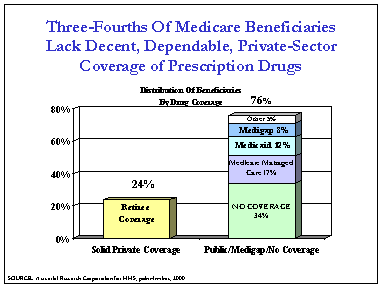         |
|
COVERAGE FOR PRESCRIPTION DRUGS FOR MEDICARE BENEFICIARIES
-
Unlike virtually all private health insurance plans, Medicare does not cover prescription drugs. As a
result, a fragmented, unstable system of coverage has emerged as beneficiaries attempt to insure against the costs
of medications.

-
Only one-fourth of Medicare beneficiaries have retiree drug coverage. Employers provide health insurance for
most Americans under the age of 65, but pay for supplemental coverage for only a fraction of their elderly retirees.
When available, this coverage tends to have reasonable cost sharing and affordable premiums.
-
About 75 percent of Medicare beneficiaries lack decent, dependable, private-sector coverage of prescription
drugs. These beneficiaries include those with:
-
Medigap. About 8 percent of beneficiaries purchase Medigap with drug coverage -- but this coverage is
frequently expensive, inaccessible and inadequate for many Medicare beneficiaries.
-
Medicare managed care. About 17 percent of beneficiaries have coverage through Medicare managed care.
Given the projected leveling off of managed care enrollment and actual declines in the scope of managed care drug
benefits, this source of coverage is unstable.
-
Medicaid and other public programs. Medicaid covers about 12 percent of beneficiaries and programs like
the Veterans’ Administration cover another 5 percent of beneficiaries. Eligibility for these programs is very
restrictive.
-
No coverage at all. 34 percent of Medicare beneficiaries has no drug coverage.
|
|
President and First Lady | Vice President and Mrs. Gore
Record of Progress | The Briefing Room
Gateway to Government | Contacting the White House
White House for Kids | White House History
White House Tours | Help | Text Only Privacy Statement | |

